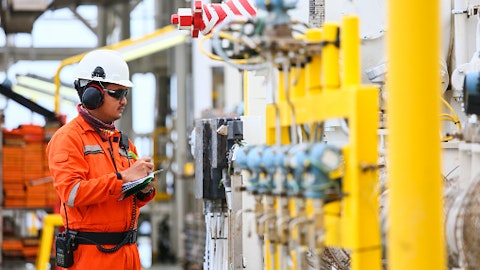Tony Petrello: Yes. And what we’re seeing, Keith, is that even for those people who have the AC rigs, their AC configurations aren’t necessarily robust enough to handle the suite of products. And so we’re in discussion with a number of contractors who are actually converting over to our SmartROS system, which gives them the robustness that they need to actually run this stuff. So, we have a conversion methodology that’s very cost effective compared to anybody else’s alternative out there in the marketplace and help them convert over to a platform that enables them to grow that part of their business. And here, I would say is — the reason why we’re doing this is Nabors recognizes with the number of rigs we have, we can’t service the whole world here, obviously.
So, that’s why we’re committed to making this technology available to on third-party rigs. And we’re actually joining up with contractors on a cooperative basis not on a compensation base, even though we’re — we compete in some areas, operators, a lot of contractors recognize that since we’ve been down the path, why reinvent the wheel. And since we’re willing to let them access the good stuff, that — it’s like a win-win proposition. So, that’s the concept that we’ve accelerated on. That’s what we’re going to press forward both here in the US and internationally. And I think the bottom-line of all of this stuff is, as you can see from the numbers, the growth has been pretty dramatic. But most importantly, the cash conversion rate is one of the things I particularly like — the cash conversion rate on NDS, to give you an idea, is 80% this year, 80%.
Keith MacKey: Got it. That’s very good color. Thanks for that. Just a follow-up on the international rig tenders. I think you said 37 tenders in MENA, another four to five–
Tony Petrello: 37 tenders for 37 rigs.
Keith MacKey: Got it. 37 tenders for 37 rigs.
Tony Petrello: No. Not 37 tenders. No. No. No. 37 rigs. Yes.
Keith MacKey: Yes. Got it. So, the question is how many of those tenders and the success of those tenders are embedded, would you say, in the $1 billion plus guidance for 2023 and then the free cash flow guidance as well? Are those –like is it an incremental 37 rigs to what you’re running now potentially? And then with that, there’d be some activation cost presumably and some cash component to that? Or maybe if you could just help us think through that a little bit more as well?
William Restrepo: That’s a great question. In reality, what we have embedded is some growth that is already achieved, as Tony mentioned. So, that includes Saudi Arabia, the standard newbuilds plus a couple of other rigs that we’ve added in other places. So, that’s already embedded. Those things are embedded. What is not embedded is any potential success on these tenders. And again, we’re not handicapping anything. But in these types of businesses or these types of markets, the client tends to help significantly with the upgrade and recertification and mobilization costs. So we don’t think that the impact on our cash flow on negative basis for reactivating these rigs should be significant.
Keith MacKey: Got it. Thanks very much. That’s it from me.
Operator: Our next question will come from Waqar Syed with ATB Capital Markets. Please go ahead.
Waqar Syed: Thank you for taking my question. I have a question on SANAD. In terms of total capital spending, I understand $180 million is going to be for newbuilds. What’s the total capital spend in SANAD for 2023?
Tony Petrello: That’s a great question. About $260 million. Saudi Arabia. That is for Saudi Arabia. A little bit of that will be incurred by Nabors itself. But yes, that’s the Saudi Arabian CapEx, including those newbuilds.
Waqar Syed: Okay. And then would it be fair to say that your guidance of $400 million plus free cash flow in 2023, all of that free cash flow will be generated outside of SANAD?
Tony Petrello: Well, actually, SANAD will consume cash. So, the cash generation outside — yes, of course, because they’re building what? $180 million or $260 million total of CapEx or $240 million or so, I guess, is the internal for SANAD. It’s more than the generation for SANAD from one year. However, outside SANAD, that cash consumption, which we think is going to be somewhere in the maybe $40 million range, is included in our consolidated number. That implies that the $400 million that I mentioned — or more than $400 million that I mentioned is going to — the piece that’s outside of SANAD is going to be higher by about $40 million, $50 million.




